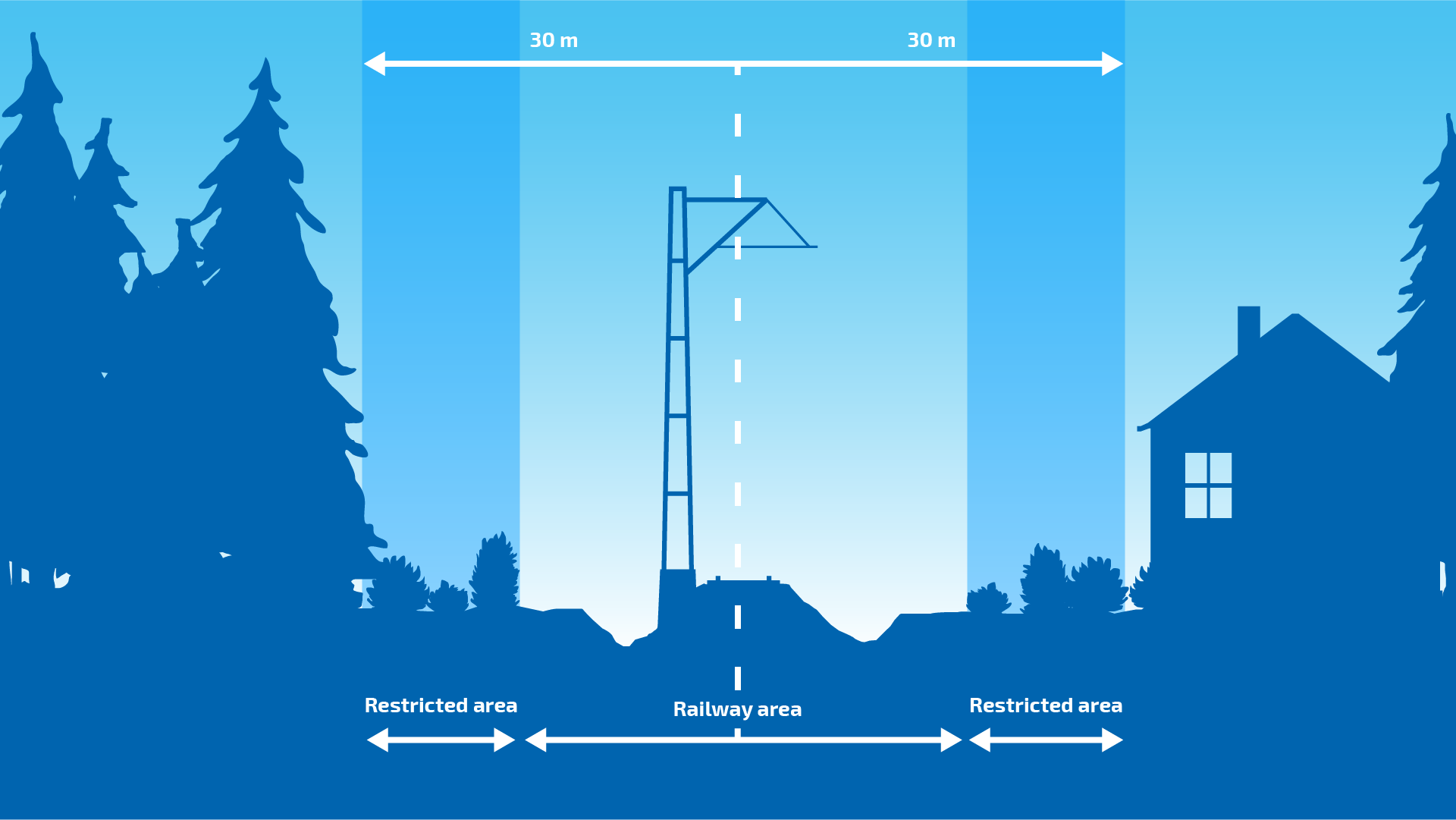Restricted areas around railway tracks
Restricted areas promote the safe use of the railway and in most cases extends 30 metres from the centre line of the single track or of the outermost track. This page contains the most important questions and answers about restricted areas around railway tracks.
What is a restricted area and who owns it?
Restricted areas promote the safe use of the railway and are established under the Railway Act. The restricted area is a fixed area that extends outside of the railway area itself. The restricted area is therefore not part of the railway area owned by the Finnish State and managed by the Finnish Transport Infrastructure Agency, but rather the owner of the property owns the restricted area.
The restricted area is subject to restrictions on its use for buildings and structures, for example, and the Finnish Transport Infrastructure Agency has the right to remove high-risk vegetation such as trees.
How far does the restricted area extend?
Under the Railway Act, the restricted area extends 30 metres from the centre line of the track or, if there is more than one, the outermost track. The restricted area may also be set as narrower or wider by separate decision, but may not be more than 50 metres wide. In practice, it has been rare to change the width of the restricted area.

Is it permitted to move around within the restricted area?
The restricted area itself does not restrict moving in the area. In contrast, unjustified trespassing on railway tracks or its immediate proximity is not only dangerous but also prohibited by law.
Is the restricted area marked in any way?
The restricted area is not marked on the terrain. The restricted area must be recorded, however, on the land register map and in the land register as a land use restriction for the properties into which the restricted area extends. The register entries are made when the property is included in a land survey project. Nevertheless, the restricted area and its effects remain in force even if it has not been recorded in this way.
What kind of land use is most common in restricted areas?
There are many types of land use in areas adjacent to the state-owned railway network and thus also in restricted areas. A restricted area may encompass forest, fields or gardens. Often the areas contain either trees and other vegetation or buildings and structures.
What measures does the Finnish Transport Infrastructure Agency carry out in restricted areas?
The most common measure to be carried out in a restricted area is the removal of high-risk trees or other high-risk vegetation that endangers traffic safety. High-risk vegetation refers to tall vegetation that, if it fell, could pose a risk to rail traffic or could impede track maintenance work or damage the railway itself.
In practice, the Finnish Transport Infrastructure Agency removes trees from the restricted area that could reach the track or its structures if they fell. Work to remove trees from the restricted area is often carried out at the same time as the removal of vegetation from the state-owned railway area. The Finnish Transport Infrastructure Agency orders the removal of trees from a tendered contractor either as part of a railway project or as separate maintenance work.
As a rule, all trees are removed from the railway area, while only trees that pose a risk, as estimated by a forestry professional, are removed from the restricted area. The removal of trees takes into account environmental factors and the different permit requirements. Any conservation areas and valuable natural sites within the restricted area are investigated in advance, and conservation needs are taken into account in the clearing work.
Is it okay for a landowner to cut down trees in a restricted area?
The owner of the property has the right to cut down trees within a restricted area. However, the removal of trees in the vicinity of the railway requires special expertise in order to ensure work and traffic safety. For this reason, we strongly recommend that the removal of high-risk trees in restricted areas be left to the Finnish Transport Infrastructure Agency.
However, if the property owner is considering independently removing such high-risk trees from their property, it is advisable to contact the FTIA-appointed track manager before starting the work. In this way, the property owner and the track manager can discuss the safety aspects of the clearing work in more detail. At worst, a tree falling on the track may cause the derailing of a train and resulting personal injuries. At the very least, a tree on the track will lead to rail transport delays and inspection costs.
Is it permitted to build or carry out excavation work in a restricted area?
It is prohibited under the Railway Act to maintain a building, structure or machine within a restricted area, and there are also restrictions on measures that modify the ground surface. The restricted area can still be used, however, and buildings located within it can be maintained in the usual way. Moreover, the prohibitions and restrictions for restricted areas do not unequivocally prevent property development.
The prohibition on holding a building, structure or machine within a restricted area prohibits, for example, buildings, structures or machines whose use could pose a risk to the safety of road or rail traffic or could impede track maintenance work. The prohibition does not apply to the holding and use of buildings, warehouses, fences or other structures or machines built in the restricted area before 15 August 2016. In the case of buildings, the prohibition also does not apply in areas covered by a zoning plan.
The restrictions on measures prohibit altering the contours of the ground, digging ditches, or carrying out other excavation work in the restricted area in such a way that the alteration may pose a risk to the safety of road or rail traffic or impede track maintenance. These restrictions must be taken into account when planning and implementing measures in the restricted area such as building or civil engineering projects, excavation work or drainage work.
What should be taken into account when purchasing residential property that extends into the restricted area?
If you acquire a plot of land in accordance with the zoning plan, the restricted area does not prevent building on the plot. However, any plot that accords with the zoning plan is still subject to the restrictions on measures that can be carried out in restricted areas, so these must be taken into account when planning and implementing a construction project in the restricted area.
When acquiring a construction site outside the area of the zoning plan, it is advisable to find out in advance whether and how the prohibition on holding a building in a restricted area would restrict the planned construction work. To clarify these matters, you can contact the Finnish Transport Infrastructure Agency.
When applying for a building permit for a restricted area, the Finnish Transport Infrastructure Agency must provide a statement on the construction work within the restricted area. In addition, a neighbour statement is required in the normal way from the Finnish Transport Infrastructure Agency when building on a property adjacent to a railway area. In addition to matters related to the restricted area, these statements also give attention to the prevention of rail traffic noise and vibration, which the builder must see to in the properties they construct.
